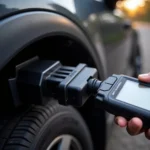A scan tool that won’t communicate can be a frustrating experience, leaving you in the dark about your car’s health. This issue can stem from problems with the scan tool itself, the vehicle’s OBD-II system, or even compatibility issues. This comprehensive guide explores the common reasons why your scan tool might not be communicating and provides practical solutions to get you back on track.
Common Causes of Scan Tool Communication Issues
Before we jump into solutions, it’s important to understand what might be causing the problem in the first place. Here are some of the most common culprits:
- Faulty OBD-II Port or Connector: Damage to the OBD-II port itself, such as bent pins or debris inside the port, can prevent a secure connection.
- Blown Fuse: The OBD-II port is usually connected to a fuse in your car’s fuse box. If this fuse blows, the scan tool won’t receive power.
- Wiring Problems: Damaged or corroded wiring in the vehicle’s OBD-II system can disrupt communication between the scan tool and the vehicle’s computer.
- Software or Driver Issues (For PC-Based Scan Tools): Outdated, corrupted, or incompatible software or drivers on your computer can prevent communication with the scan tool.
- Incompatible Scan Tool: Not all scan tools are created equal. Some scan tools may not be compatible with certain vehicle makes, models, or specific modules within a vehicle.
- Problem with the Vehicle’s Computer (ECU/PCM): In rare cases, a malfunctioning engine control unit (ECU) or powertrain control module (PCM) can cause communication problems.
Troubleshooting Steps When Your Scan Tool Won’t Communicate
If you’re facing a “scan tool will not communicate” problem, don’t panic. Here’s a step-by-step troubleshooting guide to help you identify and resolve the issue:
-
Check the Basics:
- Verify the Ignition: Ensure your vehicle’s ignition is turned to the “On” position (engine not necessarily running). This powers the OBD-II port.
- Inspect the OBD-II Port: Carefully examine the port for any visible damage, debris, or loose connections.
- Check the Scan Tool Connection: Make sure the scan tool is securely connected to the OBD-II port. Try unplugging and plugging it back in.
- Test with Another Vehicle (If Possible): If you have access to another vehicle, try connecting the scan tool to it. This helps determine if the problem is with the scan tool or your vehicle.
-
Check the Fuse: Locate your vehicle’s fuse box (usually under the dashboard or in the engine bay) and consult your owner’s manual to identify the fuse associated with the OBD-II port (often labeled “OBD,” “DLC,” or “Cigarette Lighter”). Inspect the fuse visually and replace it if blown.
-
Inspect the Wiring (Advanced): If you’re comfortable with basic car electronics, visually inspect the wiring harness leading to the OBD-II port for any signs of damage, corrosion, or loose connections.
-
Update or Reinstall Software/Drivers (For PC-Based Tools): If you’re using a PC-based scan tool, ensure you have the latest software version and drivers installed. Check the manufacturer’s website for updates.
-
Consider Compatibility:
- Vehicle Compatibility: Double-check that your scan tool is compatible with your vehicle’s make, model, and year. Some scan tools might only communicate with specific systems (engine, ABS, etc.) on certain vehicles.
- Protocol Compatibility: Vehicles use different communication protocols (e.g., CAN, ISO). Ensure your scan tool supports the protocols used by your vehicle.
-
Consult a Professional: If you’ve exhausted the basic troubleshooting steps and are still unable to establish communication, it’s best to consult a qualified mechanic or automotive electrician. They have the expertise and specialized equipment to diagnose and address more complex electrical or ECU/PCM-related issues.
Expert Insights on Scan Tool Communication
“One common mistake people make is assuming the scan tool itself is faulty when it won’t communicate,” says John Miller, a seasoned automotive diagnostician with over 20 years of experience. “Often, it’s a simple issue like a blown fuse or a loose connection. Always start with the basics before assuming the worst.”
When to Seek Professional Help
While many scan tool communication problems can be resolved with basic troubleshooting, some situations warrant professional assistance:
- You suspect a problem with your vehicle’s ECU/PCM.
- You’ve checked the fuse and wiring but can’t find the issue.
- You’re uncomfortable working with car electronics.
Conclusion
A scan tool that won’t communicate can be a roadblock to DIY diagnostics, but understanding the common causes and following these troubleshooting steps can help you get back in the driver’s seat of car maintenance. Remember to always prioritize safety and consult a professional if you’re unsure about any aspect of working on your vehicle’s electrical system. For more insights on specific scan tool issues, explore these related articles: 2012 honda civic scan tool cannot communicate with abs module, scan tool does not communicate with pcm, or clicking scan tool does not comunicate.



